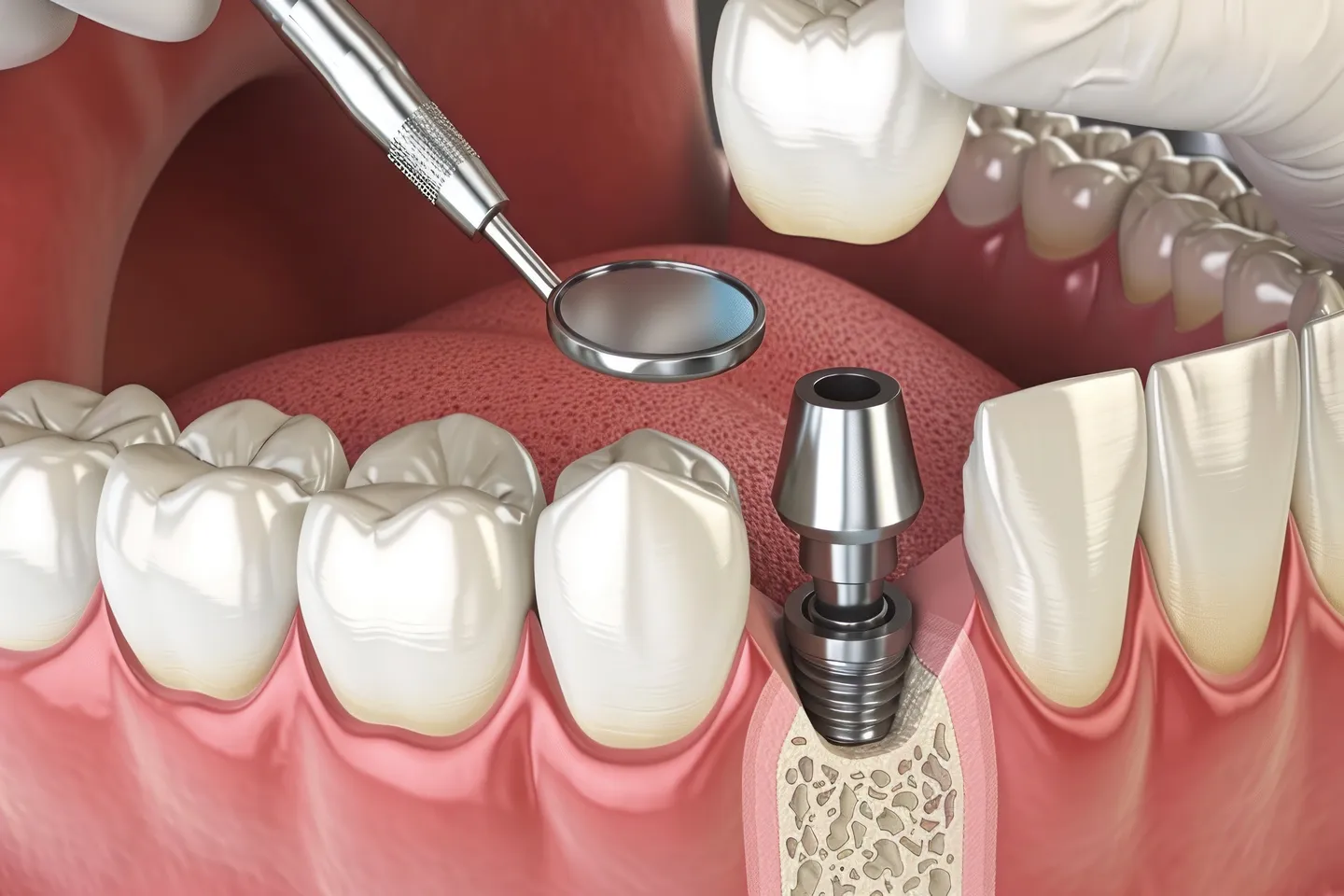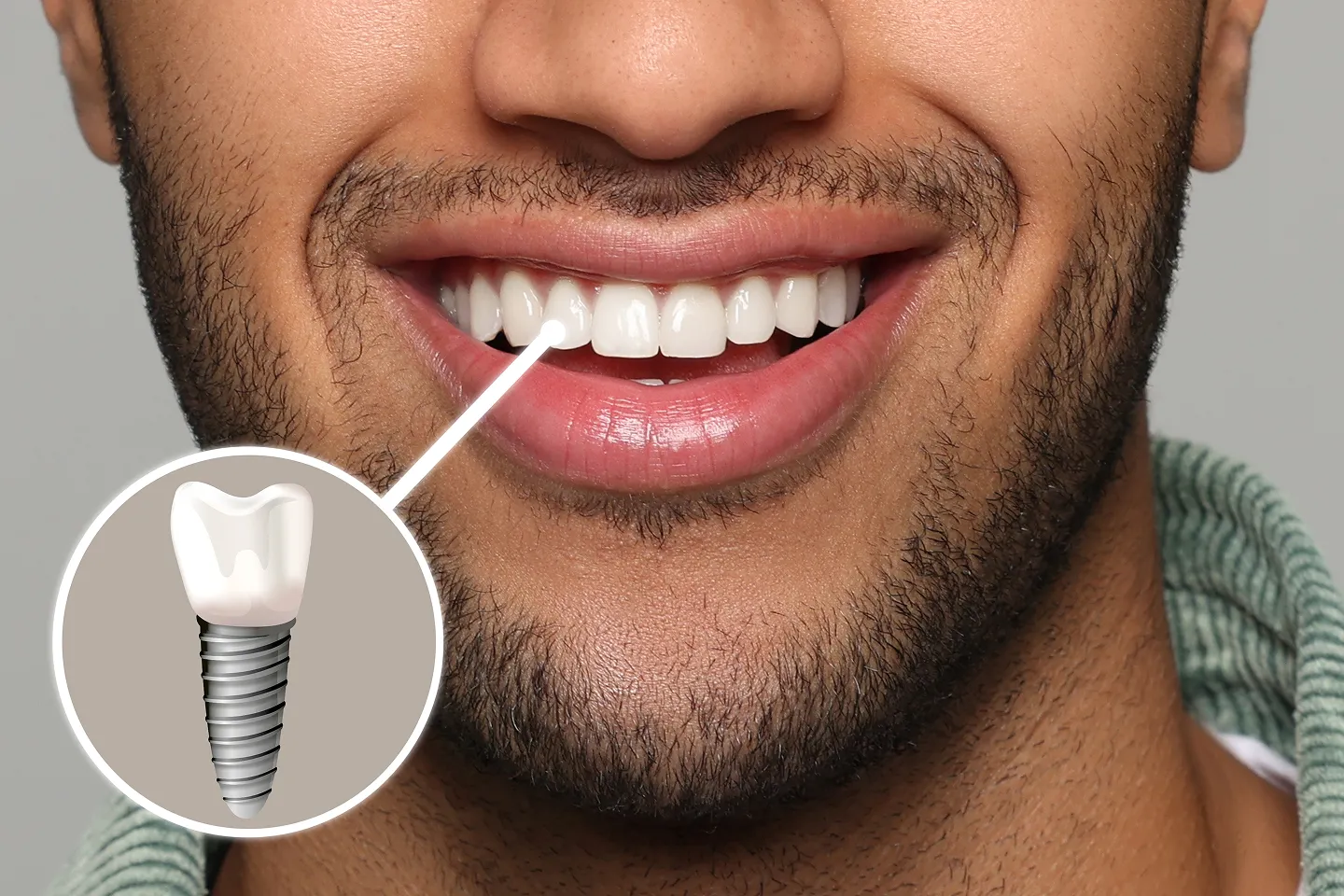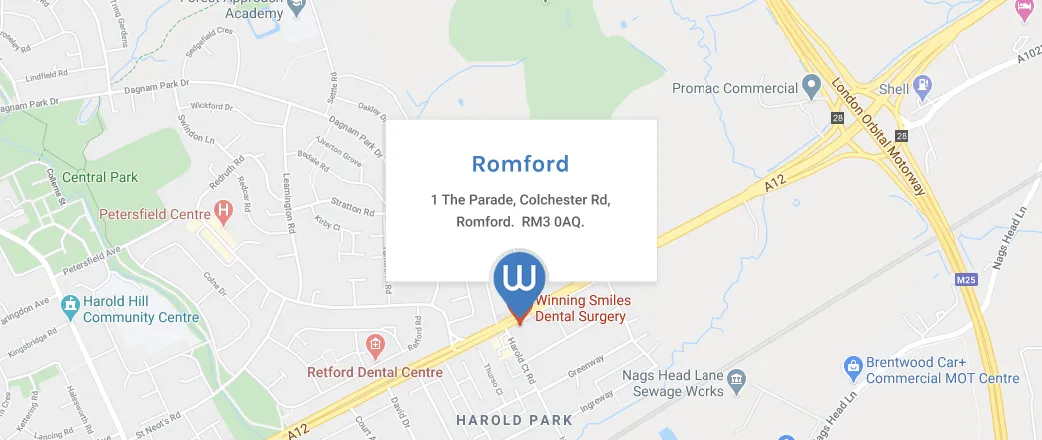Bone Grafts for the Jawbone
It is estimated that between 40% and 50% of dental implants require some sort of bone graft procedure to be carried out before, during, or after they are placed. In our clinical practice, we categorise them as either minor grafts or sinus grafts.
Minor Bone Grafts
Used to increase bone thickness around a new implant to better support it and prevent the greying of the gum over the implant area. Implants need a good thickness of bone 360 degrees around them.
If an implant is placed in bone that is less than 1 mm thick, there is not enough room for blood vessels to provide vital nutrients needed to sustain that bone, which then shrinks away and disappears.
- This creates a grey area, which is visible through the gum.
- The implant is now not fully supported and can fail mechanically due to having insufficient bone around it.
- Without a good blood supply, the area without bone becomes infected (swelling/redness/bleeding/pus) and the implant is failing.
If the pre-op CT scan shows less than 2mm of bone anywhere around the implant, then we will add bone graft chips to the area when we’re drilling and placing the implant to prevent these medium-term serious problems.
These grafts are usually carried out at the same time as the implant is placed using bone chips produced in a laboratory, often mixed with the patient’s own bone, which is a natural byproduct of drilling the hole for the implant.
There are three types of laboratory bone chips that we use here in Winning Smiles, depending on the site/bone area we are augmenting and the result we are looking for:
- Bone from a cow (bovine sourced bone chips – trade name ”bio-oss”)
- Human bone (via a human tissue laboratory, e.g., trade name ”mineross”)
- Fully synthetic bone (beta-tri-calcium-phosphate + calcium sulfate, trade name ”ethoss”)
Sinus Bone Grafts
Due to the low density and poor bone quality in the middle and towards the back of the upper jaw, many teeth fail in this area (often before the upper front teeth or lower back teeth). It is common for patients to present at the clinic with upper back teeth missing. If the very back teeth are missing, then this is not usually a big issue because the gap is not visible and the patient can still chew on the premolars in front.
However, where the middle premolar is missing (or even 3 or 4 upper back teeth), this hampers proper chewing function and shows an unsightly gap when patients smile (often leading to them smiling lopsidedly or using their hand to cover their mouths when they smile to prevent others from seeing the gap).
The middle and back upper teeth grown within the bone underneath a natural air space which is connected to the nose called the Sinus (there are other sinus air spaces in the forehead which is why you get a headache when the sinuses are blocked up, they are all connected with little channels in the bones of the face and upper jaw).
The sinus air spaces above the upper back teeth vary in size: some patients have very small sinuses and lots of bone (ideal for putting dental implants in), and less fortunate patients have naturally large sinuses and only a narrow band of bone to support the upper back teeth.
If you have large sinuses and have lost upper back teeth, there will not be enough bone volume to support dental implants.
But, this is where a sinus bone graft will be required:
Sinus Lifts (Aka Sinus Bone Graft Or Sinus Bone Augmentation)
Sinus Lifts are good because they allow patients to avoid having to wear a denture by increasing bone volume in large sinus patients to allow dental implants to be fitted. The downside is this often means an extra surgical session and a long wait. Typically, a patient waits 5 months after the sinus lift before the implants can be drilled into the new sinus bone, followed by another 4 months' wait to ensure the new implants get firm enough to support the new teeth on the implant(s) (crowns or a bridge).
Feel free to browse a gallery selection of our before-and-after photos.
Sinus Augmentation Surgery Details
(Taken from our consent letter for sinus patients)
Details written by our Chief Dental Implantologist, Andrew Fennell, here at Winning Smiles.
This is a surgical procedure carried out to increase the bone volume available in the sinus area to allow implants to be placed. The sinus lift is an internal process – there are no external scars – where the gums are peeled back in the upper molar/premolar area and a window is made through the overlying bone into the sinus space.
The lining of the sinus is then carefully raised approximately 10mm, and the resulting space is filled with a bone substitute. This acts to maintain the sinus in its new elevated position and also acts as a scaffold to allow your own bone to grow through and replace it.
The material I favour is a bone matrix derived from a human or bovine source, as the results.
They are usually excellent. There are other materials available if you have an issue with the source of this bone, but the results are less predictable.
Following the filling of the resultant cavity with the bone graft, the gums will then be sutured back to complete closure so that nothing is visible. Over 5-6 months, the bone derivative is replaced by your own bone until the area is ready for implant placement.
The sinus lift is a relatively common technique employed today with a high success rate. There are usually no adverse effects.
However, sinus lift procedures are surgical operations and, in common with all surgery, there are some attendant risks/complications that you should be aware of:
- On rare occasions, patients experience increased nasal breathing difficulties or sinus/respiratory infections following sinus lift procedures.
- There is a small risk of tearing the sinus lining (the soft lining inside the sinus space). Small tears can be repaired at the time, but if a larger tear occurs, then the procedure may need to be aborted. In this instance, it would be necessary to leave the lining to heal before considering repeating the procedure.
- In 5-8% of cases, the sinus graft material fails to integrate. This can result in an infection. In such cases, the material would need to be removed and antibiotics would be administered.
I must stress that sinus lift surgery is commonplace today and the majority of procedures take place with no complications.
Crestal sinus lifts or sinus bone graft, which is carried out as the implant is placed
Where there is too little bone to support the full length of an implant, but there is maybe 4 or 5 mm of bone available to support an implant, the sinus lift can be done from inside, and the bone can be pushed into the sinus ahead of the implant. This means that the implant can be placed at the same time as the sinus graft, cutting the overall treatment time by 50% (i.e., 4-5 months instead of 9-10).
Half of the sinus lift can be done this way: lower costs and faster treatment time.
This shows big black areas where the sinuses are and shows that there is not enough bone to put the implants in (shown in orange). You don’t have to be an implantologist to see how much bone we have after the grafting. Now we can go ahead and place two implants on each side at the back, and this allows the addition of three new back teeth on each side (using implant bridges means we still only need four implants, not six, keeping surgical complications and costs down)






.webp)
